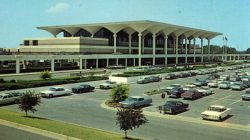American songwriter Marc Cohn’s 1991 hit, “Walking in Memphis” begins with a few lyrics that have some direct and indirect references to airlines and aviation (which is why I love the song, duh).
Check it out…
Put on my blue suede shoes
And I boarded the plane
Touched down in the land of the Delta Blues
In the middle of the pouring rain
W.C. Handy, won’t you look down over me
Yeah I got a first class ticket
But I’m as blue as a boy can be…
Little did Cohn know at the time that the word “Delta” would eventually gain much resonance in the city of Memphis, at least for a short period of time. Blue is a good word to describe the situation at Memphis International Airport right now, as its days of serving as a hub for one of the largest airlines in the world, Delta Air Lines, are officially numbered.
Not unexpected
Even though Delta lists Memphis as one of its seven hubs (along with Hartsfield-Jackson Atlanta airport, Cincinnati/Northern Kentucky airport, Detroit/Wayne County airport, Minneapolis/St. Paul airport, New York JFK airport and Salt Lake City airport), it ranks dead last in terms of overall daily frequencies among all of them. In fact, Memphis currently does not even rank among Delta’s top 10 bases in terms of weekly Available Seat Kilometers (ASKs) nor overall seats. Several “non-hub” Delta stations such as Seattle, Los Angeles and Boston offer more weekly ASKs over MEM.
It wasn’t always like this: it was once a fairly voluminous hub that Delta inherited from Northwest Airlines after the two carriers merged in 2008. Northwest had similarly inherited the hub from a separate merger with Republic Airlines in 1986. Republic was formed just after airline deregulation in 1979, following yet ANOTHER merger of two smaller carriers, North Central Airlines and Southern Airways.
Republic operated hubs at Memphis, Atlanta, Minneapolis/St. Paul and Detroit, of which three of these (all except Atlanta) would eventually become the backbone of Northwest Airlines’ domestic network system. However, when Northwest and Delta merged in the late 2000’s, once again, all four airports were regrouped under by the same hub carrier.
However, the writing is on the wall this time as chairman of the Memphis-Shelby County Airport Authority Jack Sammons stated today:
“We will no longer be a Delta hub. We will rely purely on origin and destination traffic for the Delta passengers.”
Effective September 3, 230 airport customer service employees in Memphis, as well as Delta cargo positions, will be eliminated.
Once upon a time…
…Memphis had a place on the map. At its peak in 2000, Northwest operated over 300 daily flights out of Memphis, which, if measured the same today, would place MEM as the 4th largest Delta station, behind Atlanta, Detroit and Minneapolis, and ahead of Salt Lake City, New York LaGuardia, New York JFK and Cincinnati.
KLM operated a daily flight to Amsterdam, aided by its joint-venture agreement formed with Northwest Airlines in the 1990s. Fuel was cheap and the threat of cannibalization from competing hubs was nonexistent, as Northwest’s other two megahubs at Detroit and Minneapolis/St. Paul were over 500 miles away. Northwest even experimented with some out-of-box nonstop transborder routes from Memphis to Vancouver and Mexico City for a period of time.
There was obviously a business case behind keeping MEM open as a hub in the Southeast. Back then, the US domestic hub market was much more fragmented among many competing airlines, such that there was actually room for several hubs in a single region.
In fact, Memphis almost played a critical role in competing against ten other hubs located within a 500 mile radius: Trans World Airlines (TWA) at St. Louis (245 mi away), Delta and AirTran at Atlanta (330 mi away), Delta at Cincinnati (414 mi away), American and Delta at Dallas/Ft. Worth (421 mi away), Continental at Houston (468 mi away) American and United at Chicago O’Hare (486 miles away) and US Air at Charlotte (510 miles away).
Taking all of this together, Northwest Airlines relied upon the strategic importance of Memphis against ceding market share traffic to virtually every major domestic US carrier.
That is, until the consolidation wave began.
TWA merged with American in 2000, and St. Louis eventually lost its hub status in the aftermath.
US Airways ditched its Pittsburgh hub, and America West its Columbus, OH hub, after the two carriers merged in 2005. Delta dropped its DFW hub in 2005 and greatly reduced its Cincinnati hub prior to filing for bankruptcy, then eventually merged with Northwest Airlines in 2008.
That was when things became vulnerable for Memphis. With hubs at Cincinnati, and more worrisome, Atlanta, added to the network, what would happen to its value-add?
At the time of the merger, Delta executives assured that Memphis would remain open as a hub for the merged carriers, and would see its service levels remain constant, if not increase. Memphis would serve as a “reliever hub” over the mega-hub at Atlanta a few hundred miles away, and the city appeared to cling to that rationale as the only security latch for its future.
No longer a Prayer in Memphis
The promise seemed to hold through all the way until July 2010, when Memphis stood at its post-merger peak offering 274 scheduled Delta flights. That summer, Delta maintained approximately 85% market share at MEM, which would lead one to believe that the hub would be profitable with a monopoly hold over pretty much every market served nonstop from Memphis. There were also no low-cost carriers, not even Southwest, serving Memphis at the time, sans for a few daily rotations on AirTran to Atlanta.
About 10 million passengers moved through Memphis that year, up from 9.9 million in 2009. Things seemed good – until the following summer, when Delta cut 18% of flights at Memphis down to 224 daily departures.
The situation was more alarming than appeared on paper when viewed through with a finer lense.
For starters, the vast majority of Delta-operated flights out of Memphis were operated on regional jets/commuter aircraft, meaning that they were contracted services on Delta Connection partners rather than Delta Air Lines itself. That automatically placed some skepticism over whether Delta was actually as committed to the market as it claimed to be.
Secondly, average airfares out of Memphis ranked among the top-5 highest in the U.S. at approximately $484 USD for 2011 (the average for that year was USD $386). Although Memphis ranks among the top 20 US cities population-wise, this figure was arguably too high to stimulate enough local traffic demand in order to fill a flight profitably, let alone support even a medium-sized connecting hub.
A comic published in the Memphis Flyer, taking a jab at the high-fares charged out of Memphis.
Even though an 18% schedule reduction seems marginal, the impact had a pretty big ripple effect between 2010 and 2011 at Memphis, as annual passenger traffic dropped from 10.0 million to 8.7 million within a single year.
In October 2011, Delta announced another round of cuts for 2012, whittling down daily peak-day departures to 149. A huge blow was the scale-back of the historic route from Memphis to Amsterdam, which was converted into a summer seasonal route. It was painful to think that what was once a daily KLM MD-11 service was now to become a summer-seasonal 4-weekly Delta 767 flight.
With fewer options, combined with sky-high fares, it almost became a pattern for many Memphis-based fliers to drive to Atlanta and fly out on Delta to anywhere they wanted to go, while possibly still paying less for a cheaper ticket as average airfares were far lower out of Atlanta.
A year later, Delta slashed services out of Memphis to an all-time low of 96 peak daily departures for Q1 2013. Prior to this announcement, Delta had operated a 3-bank, 50-flight hub structure out of Memphis, but with the elimination of approximately 56 flights, Delta revamped the MEM operation into a “rolling hub.”
However, this was more or less the last ditch attempt at making MEM profitable, which clearly did not have a leg to stand on. Today’s announcement essentially confirmed that after labor day, Memphis will see no more than 60 daily departures to “key cities,”
Market realties have changed between 2008 and 2013
Put simply, there were too many things going against Memphis in terms of its long-term viability as a hub, much less even a focus city, for Delta.
The largest assailant is its geography: it is located too close to a competing hub (Atlanta), as well as other surrounding hubs in the area. Consolidation, through mergers and acquisitions, will always result in streamlined capacity, and hubs that pose the risk of cannibalization due to proximity will always be in danger. Noticeably, Cincinnati is suffering a similar fate as Memphis and will likely also lose its “hub status” name in the near-future.
The second largest attack came in the form of fleet. Northwest Airlines, prior to filing for bankruptcy in 2005, was notorious for possessing a glut of fuel-thirsty fleet, especially among the McDonnell Douglas family, without future plans to replace its narrow-body aircraft with more efficient planes. DC-9s and single-class turbo-prop jets had helped keep the Memphis hub alive.
Once Delta took over the reigns years later, the situation had changed: Delta is now quickly phasing out most of the aging 50-seat regional jets used at Memphis, which are very fuel inefficient. After finalizing a contract with its pilot group recently, Delta gained the ability to replace 75% of its 50-seat jet fleet. Naturally, Memphis was bound to fall as a casualty of this decision.
Putting all of this together, it was a complete Catch-22 scenario for Delta and Memphis. The airline simply made promises in a different time and era before 50-seat jets became economically obsolete, and did not want to re-commit to the market with newer, more fuel-efficient jets. Simply put, there was no rationale for this as the same secondary and tertiary markets served by MEM could also be served from Atlanta, in higher volumes and more profitably, thanks to more connecting traffic fed through ATL.
To cover the costs of high-CASM planes, and also because it could get away with it due to monopoly control, Delta charged exhorbitant rates for its MEM-flights, which dissuaded the majority of the flying population from flying on Delta. Those who were frequent fliers and elite travelers would be subjected to an outdated fleet, with fewer premium seats (or no premium seats at all), which prompted the impetus to fly (or drive to) one of Delta’s larger connecting hubs and then onward to their final destination.
Therefore, Delta could not entice the traveling public to fill its seats at Memphis at a profitable level and a pull-down became necessary.
Whats next?
The good news for Memphis is that Southwest, via its AirTran subsidiary, will add service from MEM to Baltimore, Chicago and Orlando this August, which may help soften the blow just a bit by bringing new low-fare competition into the region, and restoring faith in the local travel market. However, in the near-term, Southwest will not be replacing Delta service to smaller-tier regions in the Southeast, nor long-haul service to Europe (obviously), and it is unlikely any major carrier will come in to fill these gaps.
For now, MEM’s biggest concern is to hopefully figure out a way to recover its annual passenger numbers, which dropped to 6.8 million in 2012, representing a 30%+ decline from 2010.
Ultimately, the airport has embraced this news as a fairly predictable reality for some time now, and Delta knew it was time to pull the plug. At least after this fall, MEM can wipe its slate clean and hope for lower-fare options, coupled with climbing passenger numbers.
Nevertheless, Memphis will join the ranks of Pittsburgh, Columbus, St. Louis, Nashville, Raleigh-Durham and a few others as a “de-hubbed” focus city that once had brighter days.




